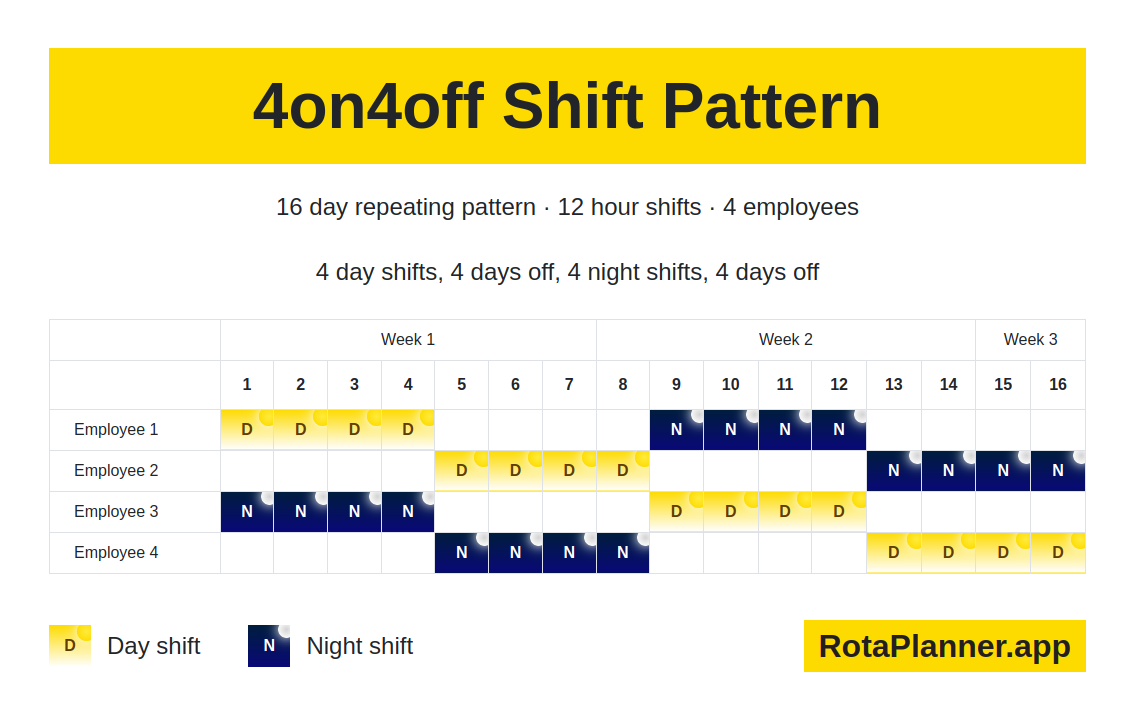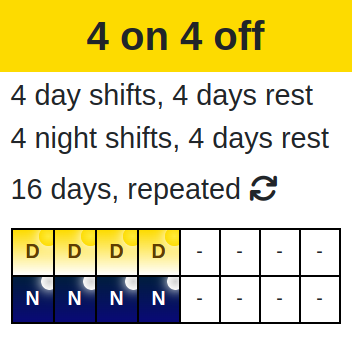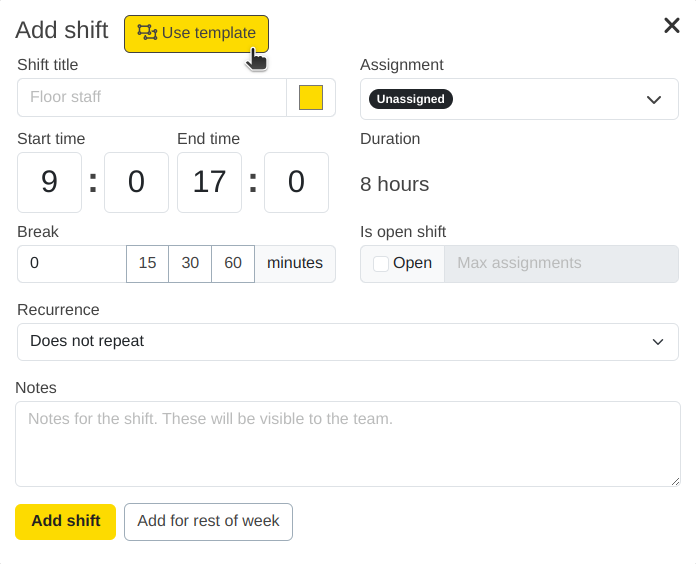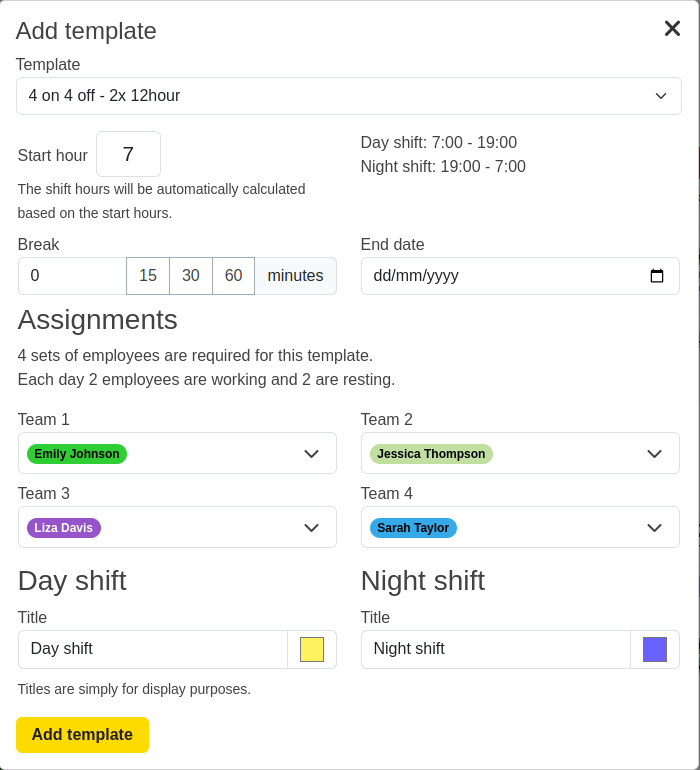
Ultimate guide to the 4 on 4 off shift pattern + Calculator, Calendar
 By Kieran - Founder
By Kieran - Founder
In this pattern, employees work 4 day shifts, 4 days off, 4 night shifts, 4 days off, creating a
rotating schedule.
We will also cover how to implement it in our
scheduling software.
Fact sheet
| Name | 4 on 4 off |
| Applicability | 24/7 coverage |
| Employees required | 4 |
| Shift length | 12 hours |
| Pattern length | 16 days (2 weeks + 2 days) |
| Pros |
|
| Cons |
|
The advantage of this schedule is that it provides employees with extended periods of time off, allowing for better work-life balance and potentially reducing fatigue associated with traditional five-day workweeks.
It also ensures continuous coverage for businesses that operate 24/7. Variations of this pattern can exist, depending on the requirements and policies of the organisation implementing it.
Create calendar for 4 on 4 off shift pattern
Use the tool below to create a calendar for the 4 on 4 off shift pattern. Customise your rota calendar by selecting your start date, entering your employee names and shift times.

Custom Shift Pattern Calculator
Our calendar tool makes it easy to create a yearly shift schedule based on the Custom pattern. Simply enter your details, and the tool will quickly generate a clear and tidy rota calendar for you.
It will also calculate how many weekends you'll be working, the total hours worked, and display everything in a neat, easy-to-read rota sheet. Use this for for planning and staying organised with your shift schedule.
Define custom pattern
Shifts
| January | ||||||
| Mon | Tue | Wed | Thu | Fri | Sat | Sun |
| 1 | 2 | 3 | 4 | 5 | ||
| 6 | 7 | 8 | 9 | 10 | 11 | 12 |
| 13 | 14 | 15 | 16 | 17 | 18 | 19 |
| 20 | 21 | 22 | 23 | 24 | 25 | 26 |
| 27 | 28 | 29 | 30 | 31 | ||
| February | ||||||
| Mon | Tue | Wed | Thu | Fri | Sat | Sun |
| 1 | 2 | |||||
| 3 | 4 | 5 | 6 | 7 | 8 | 9 |
| 10 | 11 | 12 | 13 | 14 | 15 | 16 |
| 17 | 18 | 19 | 20 | 21 | 22 | 23 |
| 24 | 25 | 26 | 27 | 28 | ||
| March | ||||||
| Mon | Tue | Wed | Thu | Fri | Sat | Sun |
| 1 | 2 | |||||
| 3 | 4 | 5 | 6 | 7 | 8 | 9 |
| 10 | 11 | 12 | 13 | 14 | 15 | 16 |
| 17 | 18 | 19 | 20 | 21 | 22 | 23 |
| 24 | 25 | 26 | 27 | 28 | 29 | 30 |
| 31 | ||||||
| April | ||||||
| Mon | Tue | Wed | Thu | Fri | Sat | Sun |
| 1 | 2 | 3 | 4 | 5 | 6 | |
| 7 | 8 | 9 | 10 | 11 | 12 | 13 |
| 14 | 15 | 16 | 17 | 18 | 19 | 20 |
| 21 | 22 | 23 | 24 | 25 | 26 | 27 |
| 28 | 29 | 30 | ||||
| May | ||||||
| Mon | Tue | Wed | Thu | Fri | Sat | Sun |
| 1 | 2 | 3 | 4 | |||
| 5 | 6 | 7 | 8 | 9 | 10 | 11 |
| 12 | 13 | 14 | 15 | 16 | 17 | 18 |
| 19 | 20 | 21 | 22 | 23 | 24 | 25 |
| 26 | 27 | 28 | 29 | 30 | 31 | |
| June | ||||||
| Mon | Tue | Wed | Thu | Fri | Sat | Sun |
| 1 | ||||||
| 2 | 3 | 4 | 5 | 6 | 7 | 8 |
| 9 | 10 | 11 | 12 | 13 | 14 | 15 |
| 16 | 17 | 18 | 19 | 20 | 21 | 22 |
| 23 | 24 | 25 | 26 | 27 | 28 | 29 |
| 30 | ||||||
| July | ||||||
| Mon | Tue | Wed | Thu | Fri | Sat | Sun |
| 1 | 2 | 3 | 4 | 5 | 6 | |
| 7 | 8 | 9 | 10 | 11 | 12 | 13 |
| 14 | 15 | 16 | 17 | 18 | 19 | 20 |
| 21 | 22 | 23 | 24 | 25 | 26 | 27 |
| 28 | 29 | 30 | 31 | |||
| August | ||||||
| Mon | Tue | Wed | Thu | Fri | Sat | Sun |
| 1 | 2 | 3 | ||||
| 4 | 5 | 6 | 7 | 8 | 9 | 10 |
| 11 | 12 | 13 | 14 | 15 | 16 | 17 |
| 18 | 19 | 20 | 21 | 22 | 23 | 24 |
| 25 | 26 | 27 | 28 | 29 | 30 | 31 |
| September | ||||||
| Mon | Tue | Wed | Thu | Fri | Sat | Sun |
| 1 | 2 | 3 | 4 | 5 | 6 | 7 |
| 8 | 9 | 10 | 11 | 12 | 13 | 14 |
| 15 | 16 | 17 | 18 | 19 | 20 | 21 |
| 22 | 23 | 24 | 25 | 26 | 27 | 28 |
| 29 | 30 | |||||
| October | ||||||
| Mon | Tue | Wed | Thu | Fri | Sat | Sun |
| 1 | 2 | 3 | 4 | 5 | ||
| 6 | 7 | 8 | 9 | 10 | 11 | 12 |
| 13 | 14 | 15 | 16 | 17 | 18 | 19 |
| 20 | 21 | 22 | 23 | 24 | 25 | 26 |
| 27 | 28 | 29 | 30 | 31 | ||
| November | ||||||
| Mon | Tue | Wed | Thu | Fri | Sat | Sun |
| 1 | 2 | |||||
| 3 | 4 | 5 | 6 | 7 | 8 | 9 |
| 10 | 11 | 12 | 13 | 14 | 15 | 16 |
| 17 | 18 | 19 | 20 | 21 | 22 | 23 |
| 24 | 25 | 26 | 27 | 28 | 29 | 30 |
| December | ||||||
| Mon | Tue | Wed | Thu | Fri | Sat | Sun |
| 1 | 2 | 3 | 4 | 5 | 6 | 7 |
| 8 | 9 | 10 | 11 | 12 | 13 | 14 |
| 15 | 16 | 17 | 18 | 19 | 20 | 21 |
| 22 | 23 | 24 | 25 | 26 | 27 | 28 |
| 29 | 30 | 31 | ||||
Turn on 'Background graphics' in the print dialog for colours to show.
Hours & wage calculator
Here's a helpful calculator to work out how many hours you would work per week, month or year in the Custom shift pattern.
You can also use this calculator to work out your weekly and monthly pay for Custom shift schedule.
Options
Results
| Hours | Pay | |
|---|---|---|
| Per week | 28.516 | $285.161 |
| Per month | 147.333 | $1,473.333 |
| Per year | 1,768 | $17,680 |
These values are based on the generated calendar above, therefore the numbers depend heavily on the start date.
Our rota software can do these calculations for you, and more.
Average weekly hours
For a Custom shift pattern, the average weekly working hours is 28.5 hours.
This assumes you're working 8-hour shifts.
Average yearly hours
Assuming 8-hour shifts, your hours per year will be 1768 hours using the Custom schedule.
You can use the calculator above to work out your hours for other variations of Custom rota pattern.
How many weekends?
With the Custom shift pattern, you will work at least one day on 38 weekends, of a total of 62 weekends in the above calendar year.
So you would work 61% of weekends with the Custom pattern.
How to implement 4on4off in RotaPlanner
We have a range of shift pattern templates that are easy to add. Here's how you add a 4 on 4 off pattern in our rota planner:
- Click the plus on your desired start day

- Select 'Use shift pattern' at the top of the modal

- Select the pattern in the pattern drop down

- Fill out the details and click 'Add pattern'.
The shift pattern is now added to your rota, here is an example of what it could look like:
The above shows a 7 till 7, 12 hour shifts in a 4 on 4 off shift pattern. You will need 4 employees/teams to cover the shifts within this pattern.
Managing assignments when using templates
If your assignments will always be the same you can specify them when creating the template. It's possible to change the assignments after the template has been added and to override the assignments on just an individual day by editing the shift instance.
If your assignments will change regularly you may wish to leave the assignments blank when creating the template. You can then assign staff to the inidivudual shifts as required.
Common shift hours 🕒
Here are the most popular shift hours for 12-hour shifts in this schedule, to allow for continuous coverage for a 24-hour operation:
- 6:00 AM
- 7:00 AM (most common)
- 8:00 AM
7:00 AM is often the most common start time for 12-hour shifts. This start time allows for a relatively early beginning to the workday while still providing a consistent schedule for employees.
Here's an example of how the 4 on 4 off shift pattern might work with a 6am start:
Person 1 - Day Shift Pattern (6:00 AM - 6:00 PM):
- Day 1 to Day 4: 6:00 AM to 6:00 PM (12-hour shift)
- Day 5 to Day 8: Off
Person 2 - Night Shift Pattern (6:00 PM - 6:00 AM):
- Day 1 to Day 4: 6:00 PM to 6:00 AM (12-hour shift)
- Day 5 to Day 8: Off
Person 3 - Day Shift Pattern (6:00 AM - 6:00 PM):
- Day 1 to Day 4: Off
- Day 5 to Day 8: 6:00 AM to 6:00 PM (12-hour shift)
Person 4 - Night Shift Pattern (6:00 PM - 6:00 AM):
- Day 1 to Day 4: Off
- Day 5 to Day 8: 6:00 PM to 6:00 AM (12-hour shift)
Why is the 4 on 4 off shift pattern so popular?
It's simple math, really. With four days off, you have ample time to tackle your never-ending to-do list. That's right, folks, four days of procrastination recovery!
The 4 on 4 off shift pattern is popular for several reasons:
-
Work-life balance: The schedule allows employees to have extended periods of time off, which can enhance work-life balance. With four consecutive days off, employees have more time for personal activities, family commitments, and leisure, which can contribute to overall job satisfaction.
-
Longer breaks: Compared to traditional five-day workweeks, the 4 on 4 off pattern provides longer breaks between work shifts. This can help reduce fatigue and burnout, as employees have more time to rest and recover.
-
Continuous coverage: Industries that require round-the-clock operations, such as manufacturing, healthcare, and emergency services, need continuous coverage. The 4 on 4 off pattern ensures that there are always employees available to cover all shifts, without the need for excessive overtime or hiring additional staff.
-
Predictability: The repeating nature of the 4 on 4 off pattern provides a predictable schedule for employees. They know their work and rest days in advance, which can help with planning personal activities and commitments outside of work.
-
Reduced commuting: With four consecutive days off, employees may have the opportunity to save on commuting costs, as they can plan their personal activities during their days off without having to travel to work.
-
Job satisfaction and retention: The 4 on 4 off pattern can contribute to higher job satisfaction and employee retention. Having a predictable and balanced schedule can improve overall job satisfaction and reduce the likelihood of burnout, leading to increased employee loyalty and longevity within the organisation.
What are some alternatives to the shift pattern?
Ever heard of the 'Popcorn Shift'? It's where you work sporadic bursts of intense productivity, followed by periods of delicious snacking.
Be careful not to burn yourself out eating all the office snacks!
There are several alternative shift patterns that organisations may consider based on their specific needs and operational requirements. Here are a few examples:
-
Fixed Shifts: In this pattern, employees work the same shift consistently, such as the day shift (e.g., 9:00 AM to 5:00 PM), evening shift (e.g., 3:00 PM to 11:00 PM), or night shift (e.g., 11:00 PM to 7:00 AM). This pattern provides stability and allows employees to plan their personal lives more easily.
-
Rotating Shifts: Rotating shift patterns involve employees rotating through different shifts, such as morning, afternoon, and night shifts. For example, employees might work the morning shift for a week, followed by the afternoon shift for a week, and then the night shift for a week. This pattern ensures fair distribution of shifts among employees but may result in more frequent changes to sleep and circadian rhythms.
-
Split Shifts: In a split shift pattern, an employee's workday is divided into two distinct shifts, typically with a significant break in between. For example, an employee might work from 6:00 AM to 10:00 AM and then have a break until returning to work from 4:00 PM to 8:00 PM. Split shifts are common in industries like transportation and hospitality.
-
5-2 Shifts: This pattern involves working five consecutive days followed by two consecutive days off. It follows a traditional Monday to Friday workweek, allowing employees to have weekends off. This pattern is commonly used in office settings and other industries that operate primarily on weekdays.
-
12-Hour Shifts: Instead of the traditional 8-hour shifts, some organisations opt for 12-hour shifts. This pattern typically involves working for three or four days in a row and then having an equal number of consecutive days off. It provides longer stretches of time off but may result in longer workdays and potentially increased fatigue.
-
Compressed Workweek: In a compressed workweek, employees work longer hours per day but have more days off. For example, instead of working 8-hour shifts for five days, employees might work 10-hour shifts for four days, resulting in an additional day off each week. This pattern allows for longer stretches of rest and can be suitable for industries that can accommodate longer workdays.
Why you should implement a rota planner for 4 on 4 off shifts
Rota planner software offers several advantages when implementing a 4 on 4 off shift pattern. It enables efficient scheduling, ensures fair allocation of shifts, helps with compliance, provides real-time visibility and communication, offers adaptability and flexibility, and provides valuable analytics and insights.
RotaPlanner.app can help you streamline the scheduling process, enhance communication, and contribute to efficient workforce management.
Add your comment
Comments
If people call in sick, DMs can end up working 24 hr shifts in rotating patterns.
good reasource

